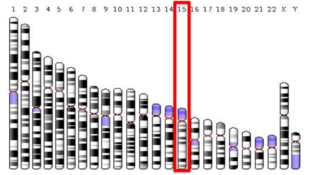
WW and C2 domain containing 2 (WWC2) is a protein that in humans is encoded by the WWC2 gene (4q35.1). Though function of WWC2 remains unknown, it has been predicted that WWC2 may play a role in cancer.

Family with sequence similarity 63, member A is a protein that, is encoded by the FAM63A gene in humans,. It is located on the minus strand of chromosome 1 at locus 1q21.3.
KIAA0753 is a protein that in humans is encoded by the gene KIAA0753. The gene is located on chromosome 17p13.1, on the reverse strand spanning bases 6578141 to 6641744. The KIAA0753 gene contains 18 exons, 19 introns, and has no known aliases.
C20orf96 is a protein-coding gene in humans. It codes for an unknown protein known as uncharacterized protein C20orf96, predicted to be a nuclear protein. The function and biological processes of the gene is not well understood by the scientific community yet.

C8orf48 is a protein that in humans is encoded by the C8orf48 gene. C8orf48 is a nuclear protein specifically predicted to be located in the nuclear lamina. C8orf48 has been found to interact with proteins that are involved in the regulation of various cellular responses like gene expression, protein secretion, cell proliferation, and inflammatory responses. This protein has been linked to breast cancer and papillary thyroid carcinoma.

Ankyrin repeat domain-containing protein 24 is a protein in humans that is coded for by the ANKRD24 gene. The gene is also known as KIAA1981. The protein's function in humans is currently unknown. ANKRD24 is in the protein family that contains ankyrin-repeat domains.
TMEM156 is a gene that encodes the transmembrane protein 156 (TMEM156) in Homo sapiens. It has the clone name of FLJ23235.

PRR29 is a protein encoded by the PRR29 gene located in humans on chromosome 17 at 17q23.

Transmembrane Protein 176B, or TMEM176B is a transmembrane protein that in humans is encoded by the TMEM176B gene. It is thought to play a role in the process of maturation of dendritic cells.
Uncharacterized protein Chromosome 16 Open Reading Frame 71 is a protein in humans, encoded by the C16orf71 gene. The gene is expressed in epithelial tissue of the respiratory system, adipose tissue, and the testes. Predicted associated biological processes of the gene include regulation of the cell cycle, cell proliferation, apoptosis, and cell differentiation in those tissue types. 1357 bp of the gene are antisense to spliced genes ZNF500 and ANKS3, indicating the possibility of regulated alternate expression.
Cardiac-enriched FHL2-interacting protein (CEFIP) is a protein encoded by the gene C10orf71 on chromosome 10 open reading frame 71. It is primarily understood that this gene is moderately expressed in muscle tissue and cardiac tissue.

Transmembrane and coiled-coil domains 4, TMCO4, is a protein in humans that is encoded by the TMCO4 gene. Currently, its function is not well defined. It is transmembrane protein that is predicted to cross the endoplasmic reticulum membrane three times. TMCO4 interacts with other proteins known to play a role in cancer development, hinting at a possible role in the disease of cancer.
The Family with sequence similarity 149 member B1 is an uncharacterized protein encoded by the human FAM149B1 gene, with one alias KIAA0974. The protein resides in the nucleus of the cell. The predicted secondary structure of the gene contains multiple alpha-helices, with a few beta-sheet structures. The gene is conserved in mammals, birds, reptiles, fish, and some invertebrates. The protein encoded by this gene contains a DUF3719 protein domain, which is conserved across its orthologues. The protein is expressed at slightly below average levels in most human tissue types, with high expression in brain, kidney, and testes tissues, while showing relatively low expression levels in pancreas tissues.

C17orf53 is a gene in humans that encodes a protein known as C17orf53, uncharacterized protein C17orf53. It has been shown to target the nucleus, with minor localization in the cytoplasm. Based on current findings C17orf53 is predicted to perform functions of transport, however further research into the protein could provide more specific evidence regarding its function.

Chromosome 21 Open Reading Frame 58 (C21orf58) is a protein that in humans is encoded by the C21orf58 gene.

C15orf39 is a protein that in humans is encoded by the Chromosome 15 open reading frame 15 (C15orf39) gene.

TMEM44 is a protein that in humans is encoded by the TMEM44 gene. DKFZp686O18124 is a synonym of TMEM44.

Tubulin epsilon and delta complex 2 (TEDC2), also known as Chromosome 16 open reading frame 59 (C16orf59), is a protein that in humans is encoded by the TEDC2 gene. Its NCBI accession number is NP_079384.2.

Transmembrane protein 221 (TMEM221) is a protein that in humans is encoded by the TMEM221 gene. The function of TMEM221 is currently not well understood.
C3orf56 is a protein encoding gene found on chromosome 3. Although, the structure and function of the protein is not well understood, it is known that the C3orf56 protein is exclusively expressed in metaphase II of oocytes and degrades as the oocyte develops towards the blastocyst stage. Degradation of the C3orf56 protein suggests that this gene plays a role in the progression from maternal to embryonic genome and in embryonic genome activation.
















